|
Brief
description and history
A church has stood on this town centre site from
at least the Middle Ages and probably much longer than that. The
earliest remains, dating from the 13th century, are to be found in
the north and south transepts. Much of the rest of the
building, including the central tower, dates from the 15th
century.
In St. Catherine's Chapel can be found the
Monmouth Rebellion brass. It commemorates Edward Coker who was
killed in East Street (reputedly by a bullet fired from an
upstairs window in the Bull Hotel) by one of the Duke of
Monmouth's officers in 1685.
In the Victorian period considerable alterations
and enlargement took place. In the ten months leading up to July
1860 a major restoration was carried out: the chancel was
completely rebuilt, and the nave lengthened by two bays. The
subsequent enlargement enabled the galleries to be removed without
reducing the seating capacity.
Thomas Hardy did not approve of the alterations.
"The church", he wrote, "had had such a
practical joke played upon it by some facetious restorer or other
as to be scarce recognisable...".
Yet, despite Hardy's disapproval, the church
continued to be much loved and late 19th and 20th century
craftsmen continued to enhance it with stained glass and the organ
we see and hear today. The Lady chapel was created in 1900. The
east window is Victorian and depicts the Queen [Victoria] as the
Queen of Sheba.
|



